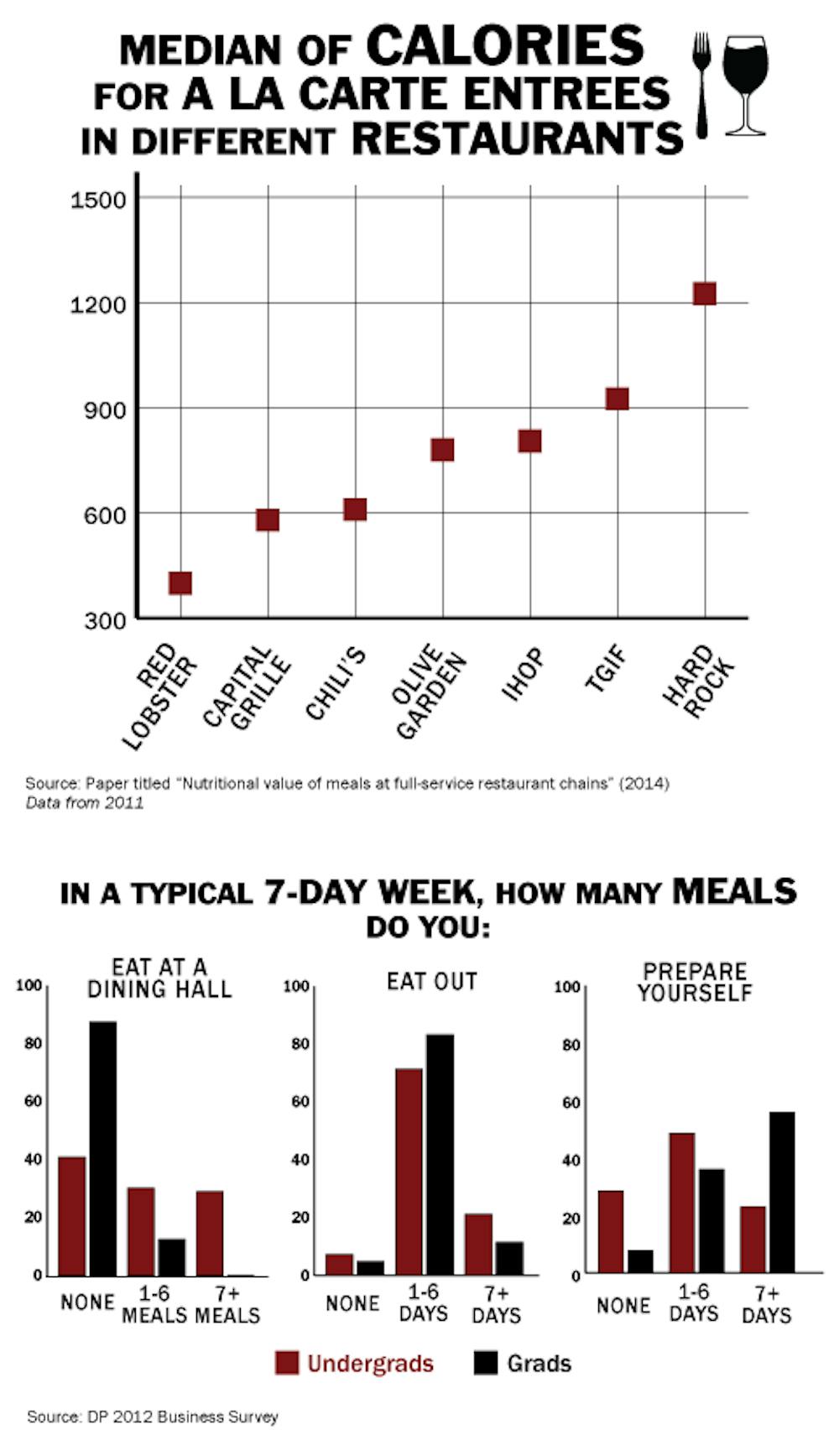
You might want to think twice before you leave your dorm room for dinner tonight.
A study published by researchers at Penn and Drexel University found that 30 percent of the entrees and appetizers offered at restaurant chains in Philadelphia exceeded the total amount of saturated fat and sodium you should eat in an entire day. The average meal, which consists of an entrée, side dish and half of an appetizer, contains 1,495 calories. If you add a non-alcoholic drink and split dessert, that number jumps to 2,020, also exceeding the recommended daily limit.
The study was conducted with 21 restaurant chains operating throughout all of Philadelphia, but the results seem to ring true right here on Penn’s campus. A 2012 Daily Pennsylvanian marketing survey found that 21.2 percent of Penn undergraduates eat out seven or more times in a typical week, while 28.6 percent don’t eat any meals prepared in someone’s home.
Related: Nearby restaurants to display meals’ nutritional value
The percent of undergraduates eating out seven or more times in a week changes significantly by class year: with 7 percent of freshmen, 24.1 percent of sophomores, 30.6 percent of juniors and 25.9 percent of seniors eating out that frequently. For the entire Penn community, including faculty and staff, the number drops to 14.2 percent.
“I think it’s symptomatic of what we’re seeing happen to the American diet at large,” Giridhar Mallya, director of policy and planning at the Philadelphia Department of Public Health said. “More and more people are eating outside of the home, and more are eating at irregular and inconsistent times.”
An earlier national study found that meals and snacks prepared away from home contained more calories, total fat and saturated fat than food prepared at home.
Prior to the Penn and Drexel study, researchers overlooked the particular case of restaurant chains, since there aren’t many chains that need to report information about their food. In 2008, Philadelphia passed a law that required restaurant chains to report their food’s calories, saturated fat, carbohydrates and sodium, giving researchers an opportunity to see what goes into your Applebee’s dessert.
“Restaurants think that they need to serve large portions to be competitive or that they need to give people more for their money,” Karen Glanz, one of the study’s researchers and a Penn School of Nursing professor said. “What it amounts to is that people often eat what’s put in front of them, and in restaurants that’s often a lot.”
Even popular restaurants that are thought to serve healthy foods fall into this pattern. The average number of calories in a single entrée at The Capital Grille was almost 600, and at Olive Garden was nearly 800. Red Lobster had the smallest number of calories at almost 400, and Hard Rock Café topped the list with over 1,200 calories for an entrée alone.
Related: Possible meal plan adjustments on UA agenda
A meal that’s high in calories will also probably be just as high in fat, carbohydrates and protein, Glanz said. “Calories is probably the biggest headline because the more calories you have, the more you have of pretty much everything else,” she added.
“With calories, we’ve seen about a two to three fold increase in rates of obesity in the United States That’s accounted for by an increase in 100 to 150 calories per day compared to 20 or 30 years ago,” Mallya said. “That may not seem like a lot, but over time, it’s these sorts of differences that account for the change.”
With increasing rates of obesity, heart disease, stroke and high blood pressure, nutritionists and policy experts are trying to make the public, as well as food establishments, more aware of these health concerns.
Amy Auchincloss, the study’s lead researcher and an assistant professor at Drexel, emailed a detailed summary of her research to 70 full-service restaurant owners, operators and chefs, as well as leaders at the National Restaurant Association. The summary urges restaurants to reduce portion sizes, lower the amount of saturated fat and salt in the food and include nutrition information for each menu item.
A similar study that was published a month earlier — also involving Auchincloss, Glanz and the Philadelphia Department of Public Health —found that customers of Philadelphia restaurants that had detailed food labels ate on average 155 fewer calories and 224 fewer grams of sodium than at the same chain restaurants outside of Philadelphia, which didn’t have those labels. The study concludes that people are using these labels to make informed decisions.
However, new legislation under the Affordable Care Act makes the future of food labeling in Philadelphia unclear. This law, which supersedes the Philadelphia law requiring detailed food labels, has yet to establish regulations on labeling. Currently, restaurants no longer have to provide food labels, and the number of restaurants using the labels has dropped from 65 to 45 percent.
“Right now we are in somewhat of a state of limbo,” Mallya said.
The Daily Pennsylvanian is an independent, student-run newspaper. Please consider making a donation to support the coverage that shapes the University. Your generosity ensures a future of strong journalism at Penn.
DonatePlease note All comments are eligible for publication in The Daily Pennsylvanian.





